RecruitTrackPro Developer Guide
Acknowledgements
- This project is based on the AddressBook-Level3 project created by the SE-EDU initiative.
Setting up, getting started
Refer to the guide Setting up and getting started.
Design
Architecture
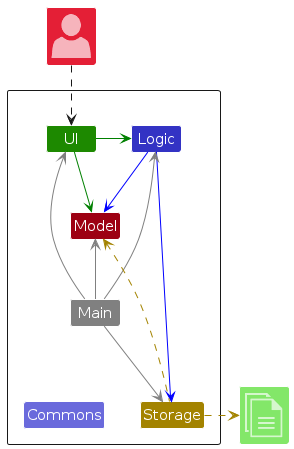
The Architecture Diagram given above explains the high-level design of the App.
Given below is a quick overview of main components and how they interact with each other.
Main components of the architecture
Main (consisting of classes Main and MainApp) is in charge of the app launch and shut down.
- At app launch, it initializes the other components in the correct sequence, and connects them up with each other.
- At shut down, it shuts down the other components and invokes cleanup methods where necessary.
The bulk of the app's work is done by the following four components:
UI: The UI of the App.Logic: The command executor.Model: Holds the data of the App in memory.Storage: Reads data from, and writes data to, the hard disk.
Commons represents a collection of classes used by multiple other components.
How the architecture components interact with each other
The Sequence Diagram below shows how the components interact with each other for the scenario where the user issues the command delete 1.
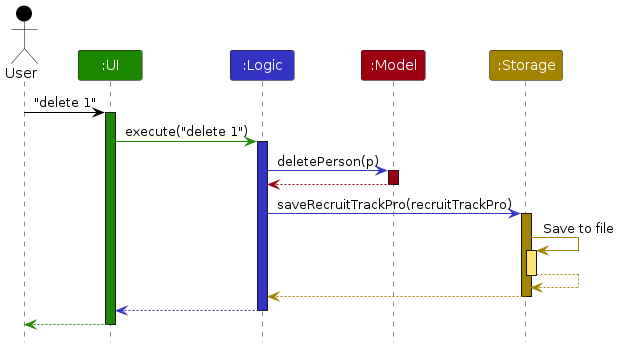
Each of the four main components (also shown in the diagram above),
- defines its API in an
interfacewith the same name as the Component. - implements its functionality using a concrete
{Component Name}Managerclass (which follows the corresponding APIinterfacementioned in the previous point.
For example, the Logic component defines its API in the Logic.java interface and implements its functionality using the LogicManager.java class which follows the Logic interface. Other components interact with a given component through its interface rather than the concrete class (reason: to prevent outside component's being coupled to the implementation of a component), as illustrated in the (partial) class diagram below.
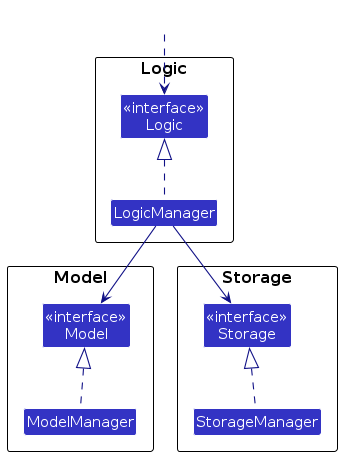
The sections below give more details of each component.
UI component
The API of this component is specified in Ui.java
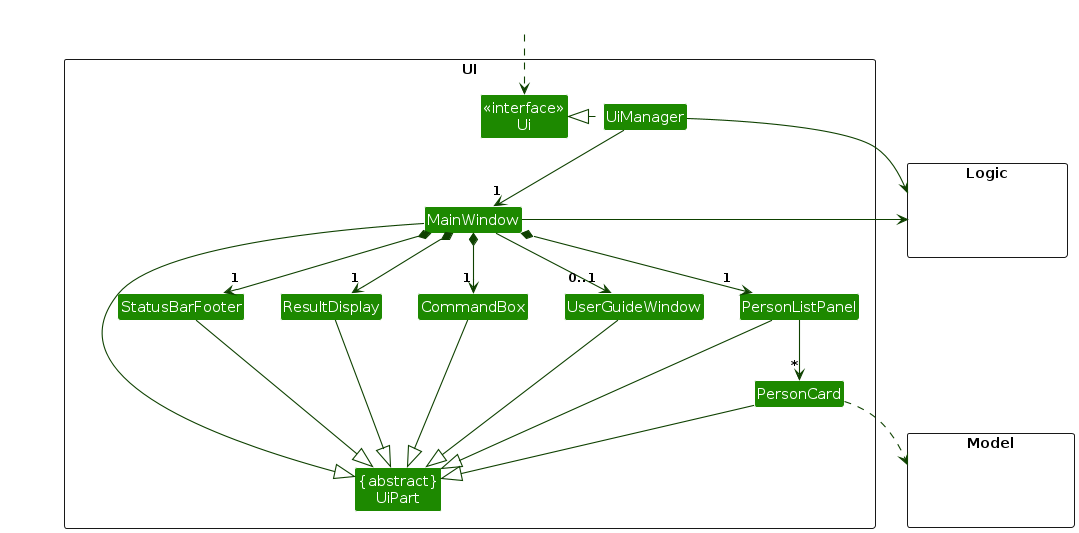
The UI consists of a MainWindow that is made up of parts e.g.CommandBox, ResultDisplay, PersonListPanel, StatusBarFooter etc. All these, including the MainWindow, inherit from the abstract UiPart class which captures the commonalities between classes that represent parts of the visible GUI.
The UI component uses the JavaFx UI framework. The layout of these UI parts are defined in matching .fxml files that are in the src/main/resources/view folder. For example, the layout of the MainWindow is specified in MainWindow.fxml
The UI component,
- executes user commands using the
Logiccomponent. - listens for changes to
Modeldata so that the UI can be updated with the modified data. - keeps a reference to the
Logiccomponent, because theUIrelies on theLogicto execute commands. - depends on some classes in the
Modelcomponent, as it displaysPersonobject residing in theModel.
Logic component
API : Logic.java
Here's a (partial) class diagram of the Logic component:
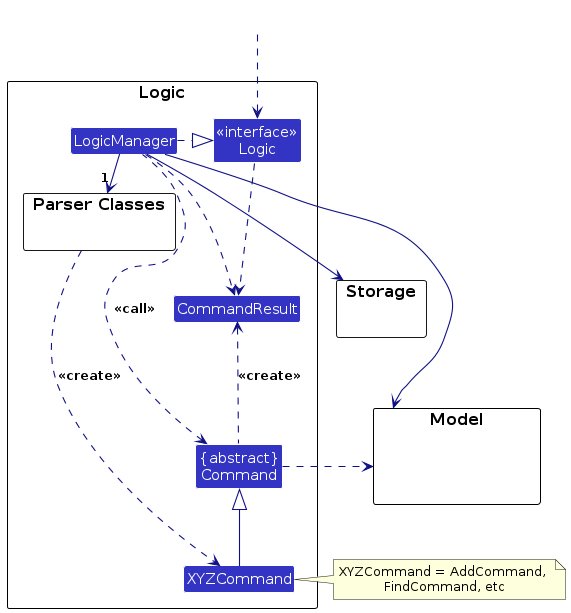
The sequence diagram below illustrates the interactions within the Logic component, taking execute("delete 1") API call as an example.
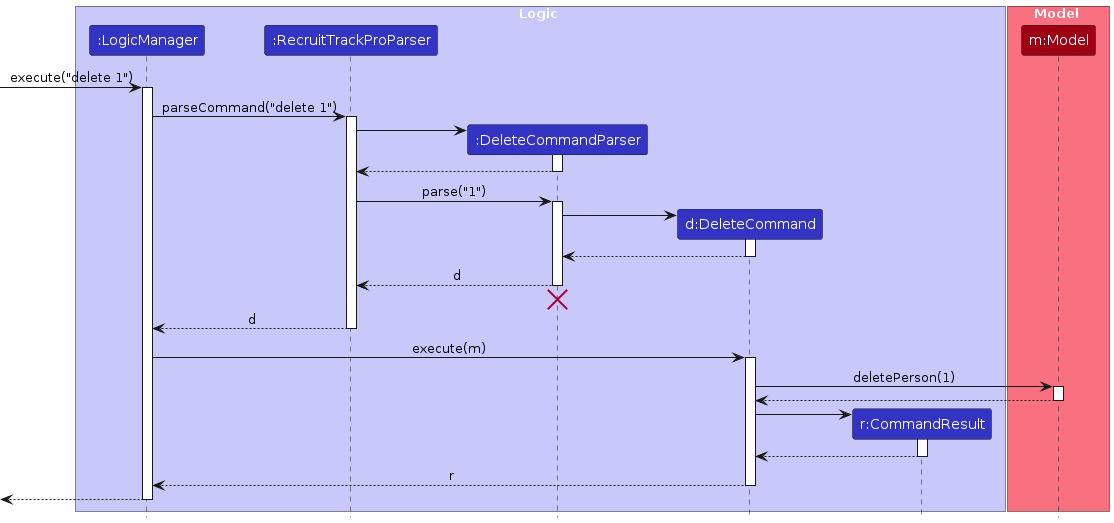
Note: The lifeline for DeleteCommandParser should end at the destroy marker (X) but due to a limitation of PlantUML, the lifeline continues till the end of diagram.
How the Logic component works:
- When
Logicis called upon to execute a command, it is passed to anRecruitTrackProParserobject which in turn creates a parser that matches the command (e.g.,DeleteCommandParser) and uses it to parse the command. - This results in a
Commandobject (more precisely, an object of one of its subclasses e.g.,DeleteCommand) which is executed by theLogicManager. - The command can communicate with the
Modelwhen it is executed (e.g. to delete a person).
Note that although this is shown as a single step in the diagram above (for simplicity), in the code it can take several interactions (between the command object and theModel) to achieve. - The result of the command execution is encapsulated as a
CommandResultobject which is returned back fromLogic.
Here are the other classes in Logic (omitted from the class diagram above) that are used for parsing a user command:
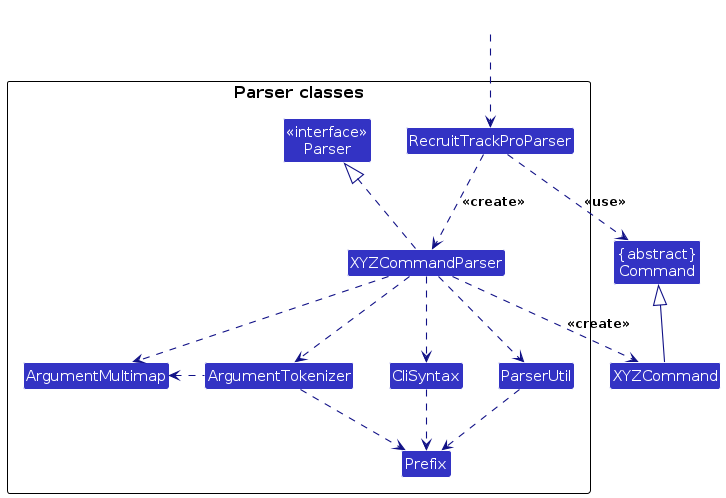
How the parsing works:
- When called upon to parse a user command, the
RecruitTrackProParserclass creates anXYZCommandParser(XYZis a placeholder for the specific command name e.g.,AddCommandParser) which uses the other classes shown above to parse the user command and create aXYZCommandobject (e.g.,AddCommand) which theRecruitTrackProParserreturns back as aCommandobject. - All
XYZCommandParserclasses (e.g.,AddCommandParser,DeleteCommandParser, ...) inherit from theParserinterface so that they can be treated similarly where possible e.g, during testing.
Model component
API : Model.java
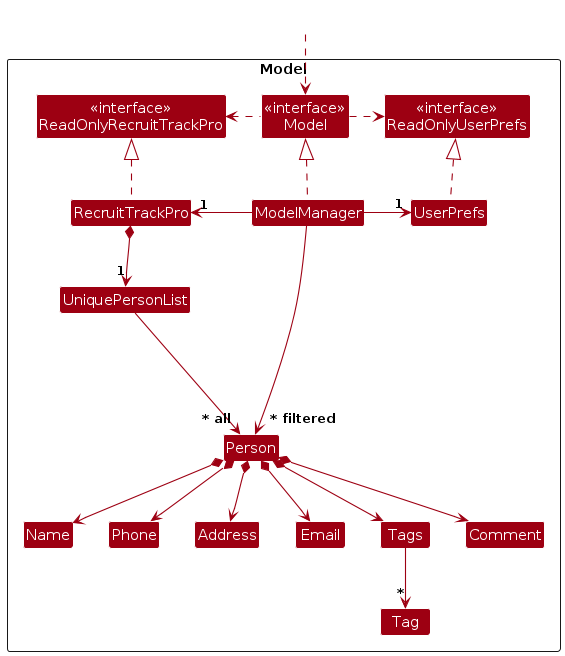
The Model component,
- stores the recruit track pro data i.e., all
Personobjects (which are contained in aUniquePersonListobject). - stores the currently 'selected'
Personobjects (e.g., results of a search query) as a separate filtered list which is exposed to outsiders as an unmodifiableObservableList<Person>that can be 'observed' e.g. the UI can be bound to this list so that the UI automatically updates when the data in the list change. - stores a
UserPrefobject that represents the user’s preferences. This is exposed to the outside as aReadOnlyUserPrefobjects. - does not depend on any of the other three components (as the
Modelrepresents data entities of the domain, they should make sense on their own without depending on other components)
Note: An alternative (arguably, a more OOP) model is given below. It has a Tag list in the RecruitTrackPro, which Person references. This allows RecruitTrackPro to only require one Tag object per unique tag, instead of each Person needing their own Tag objects.
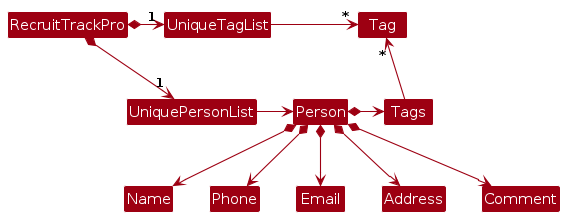
Storage component
API : Storage.java
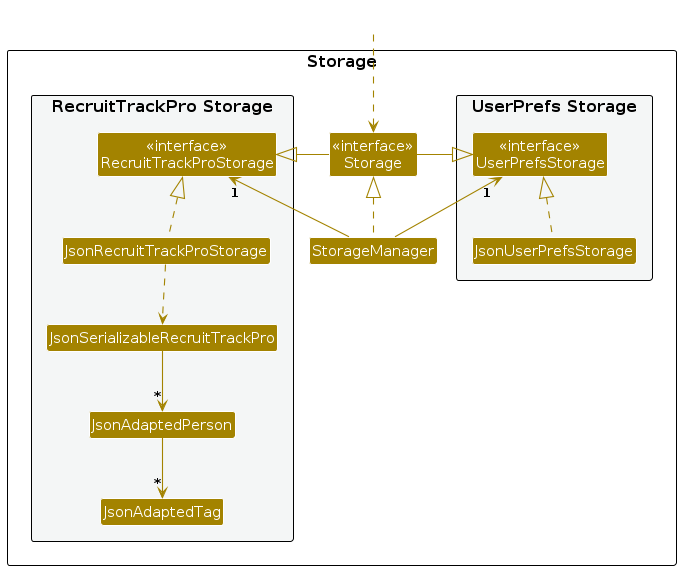
The Storage component,
- can save both RecruitTrackPro data and user preference data in JSON format, and read them back into corresponding objects.
- inherits from both
RecruitTrackProStorageandUserPrefStorage, which means it can be treated as either one (if only the functionality of only one is needed). - depends on some classes in the
Modelcomponent (because theStoragecomponent's job is to save/retrieve objects that belong to theModel)
Common classes
Classes used by multiple components are in the seedu.recruittrackpro.commons package.
Implementation
This section describes some noteworthy details on how certain features are implemented.
Add tags feature
Given below is the activity diagram of a AddTagsCommand.
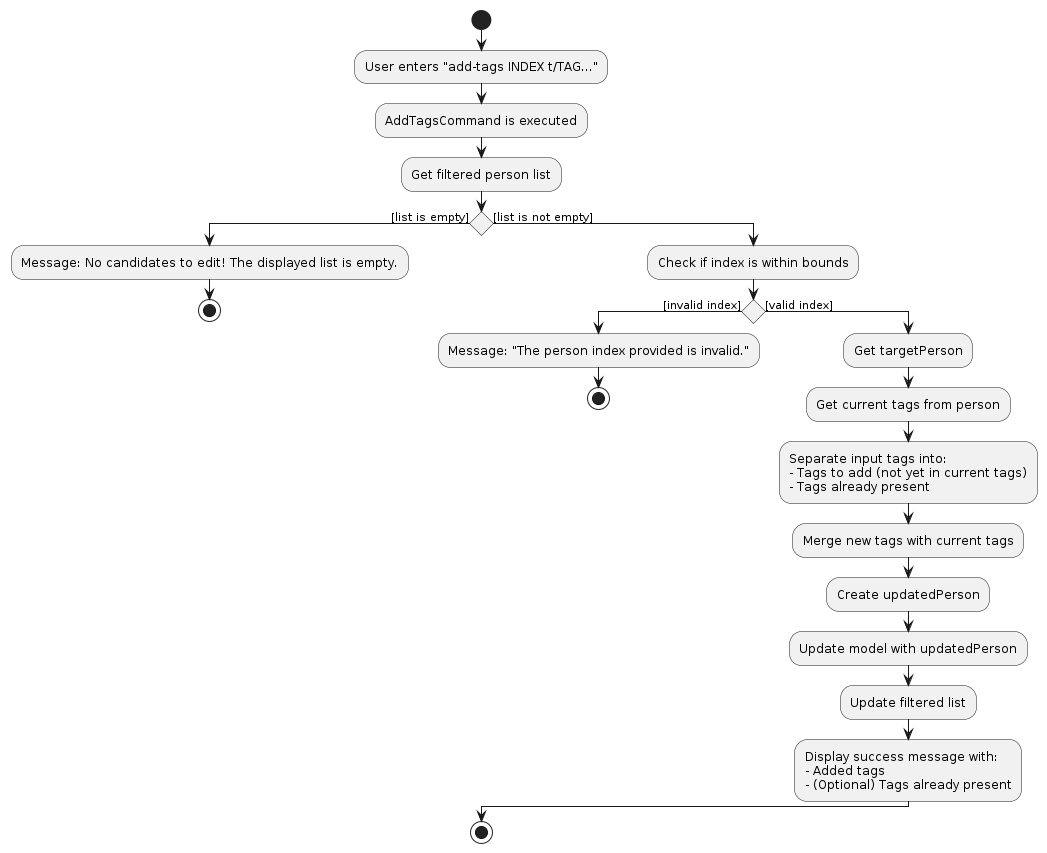
Remove tags feature
Given below is the activity diagram of a RemoveTagsCommand.
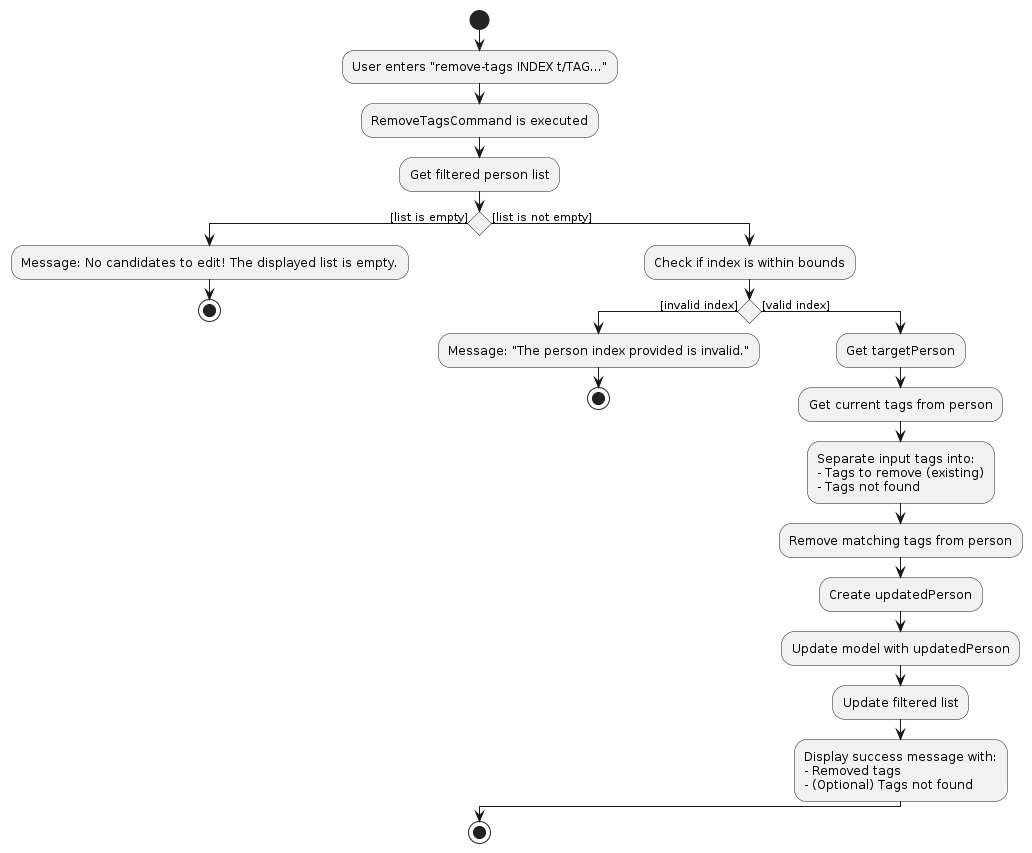
Edit tag feature
Given below is the activity diagram of a EditTagCommand.
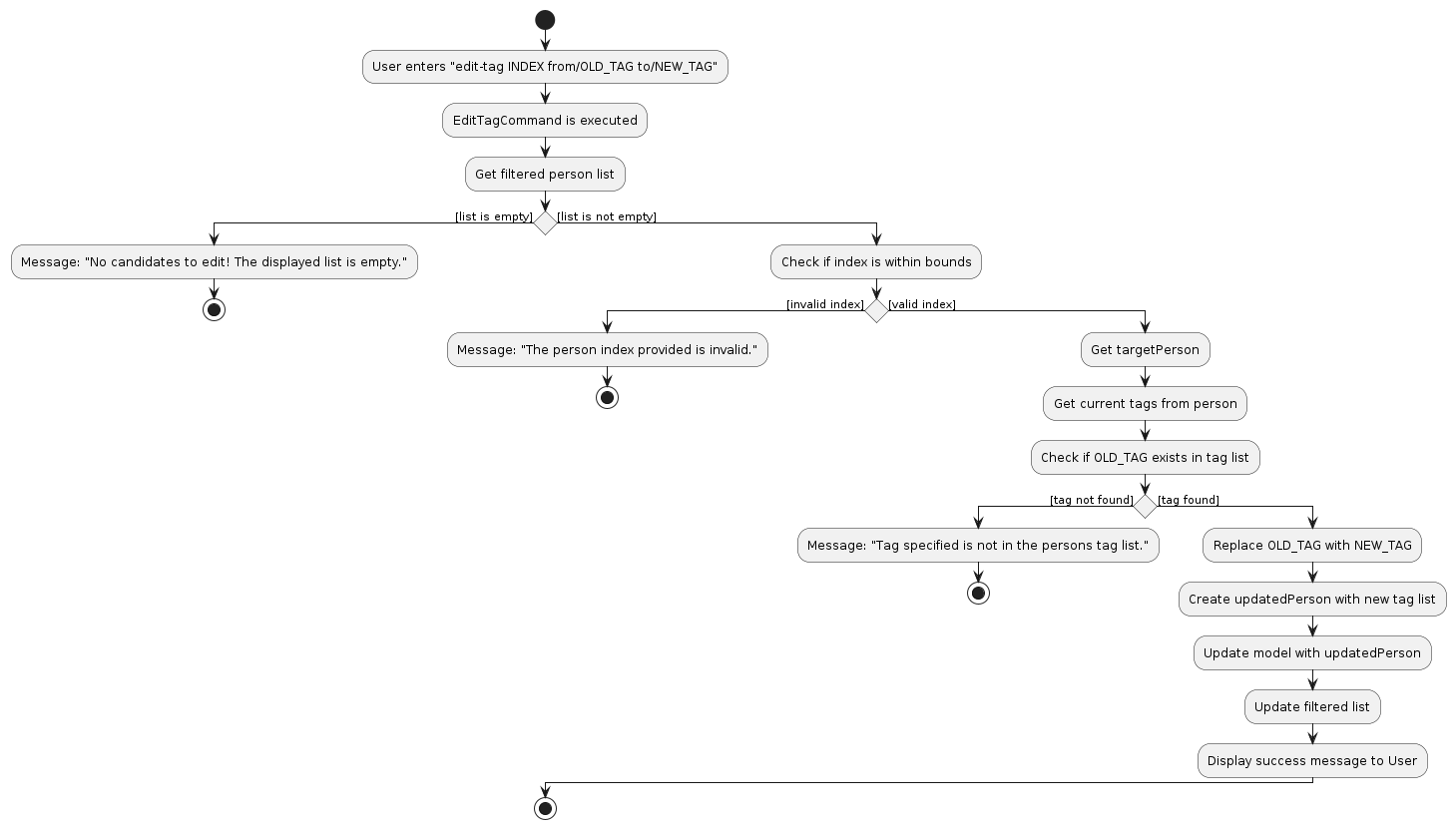
Find by tag feature
Given below is the activity diagram of a FindCommand using a t/ prefix only.
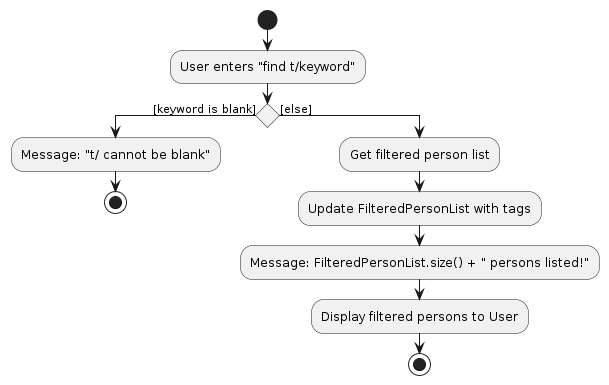
Switch sort feature
Given below is the activity diagram of a SwitchSortCommand.
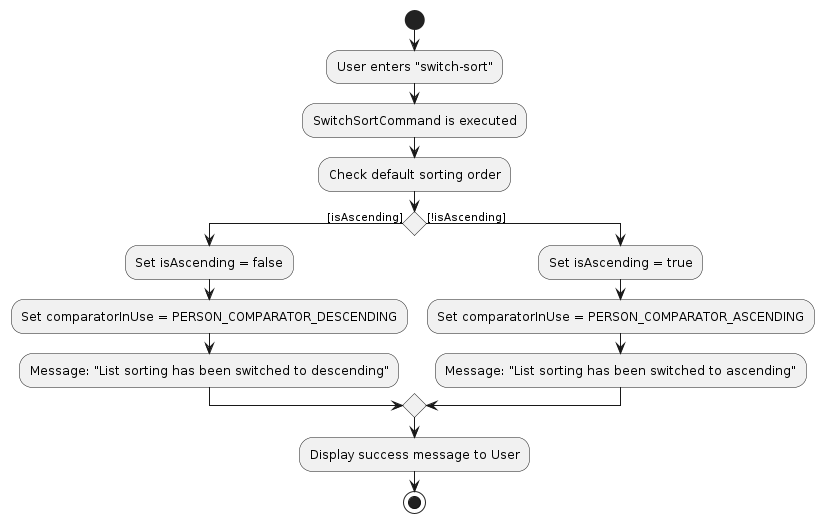
[Proposed] Undo/redo feature
Proposed Implementation
The proposed undo/redo mechanism is facilitated by VersionedRecruitTrackPro. It extends RecruitTrackPro with an undo/redo history, stored internally as an recruitTrackProStateList and currentStatePointer. Additionally, it implements the following operations:
VersionedRecruitTrackPro#commit()— Saves the current RecruitTrackPro state in its history.VersionedRecruitTrackPro#undo()— Restores the previous RecruitTrackPro state from its history.VersionedRecruitTrackPro#redo()— Restores a previously undone RecruitTrackPro state from its history.
These operations are exposed in the Model interface as Model#commitRecruiTrackPro(), Model#undoRecruiTrackPro() and Model#redoRecruiTrackPro() respectively.
Given below is an example usage scenario and how the undo/redo mechanism behaves at each step.
Step 1. The user launches the application for the first time. The VersionedRecruitTrackPro will be initialized with the initial RecruitTrackPro state, and the currentStatePointer pointing to that single RecruitTrackPro state.
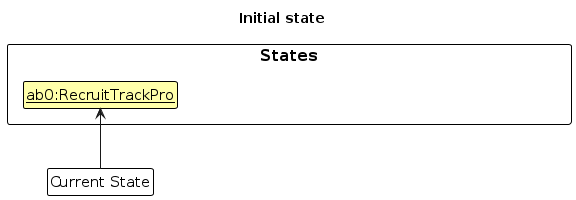
Step 2. The user executes delete 5 command to delete the 5th candidate in RecruitTrackPro. The delete command calls Model#commitRecruitTrackPro(), causing the modified state of RecruitTrackPro after the delete 5 command executes to be saved in the recruitTrackProStateList, and the currentStatePointer is shifted to the newly inserted RecruitTrackPro state.

Step 3. The user executes add n/David … to add a new candidate. The add command also calls Model#commitRecruitTrackPro(), causing another modified RecruitTrackPro state to be saved into the recruitTrackProStateList.
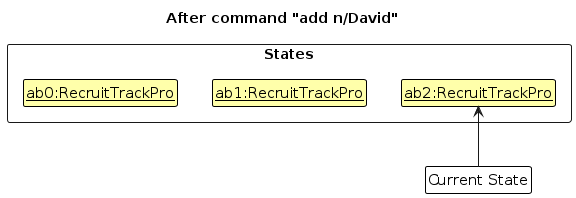
Note: If a command fails its execution, it will not call Model#commitRecruitTrackPro(), so the RecruitTrackPro state will not be saved into the recruitTrackProStateList.
Step 4. The user now decides that adding the candidate was a mistake, and decides to undo that action by executing the undo command. The undo command will call Model#undoRecruitTrackPro(), which will shift the currentStatePointer once to the left, pointing it to the previous RecruitTrackPro state, and restores the RecruitTrackPro application to that state.
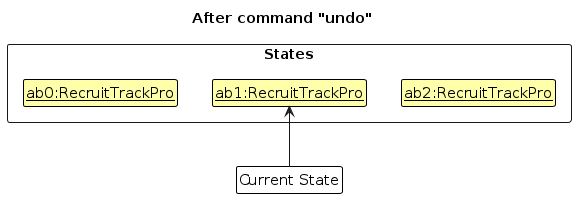
Note: If the currentStatePointer is at index 0, pointing to the initial RecruitTrackPro state, then there are no previous RecruitTrackPro states to restore. The undo command uses Model#canUndoRecruitTrackPro() to check if this is the case. If so, it will return an error to the user rather
than attempting to perform the undo.
The following sequence diagram shows how an undo operation goes through the Logic component:
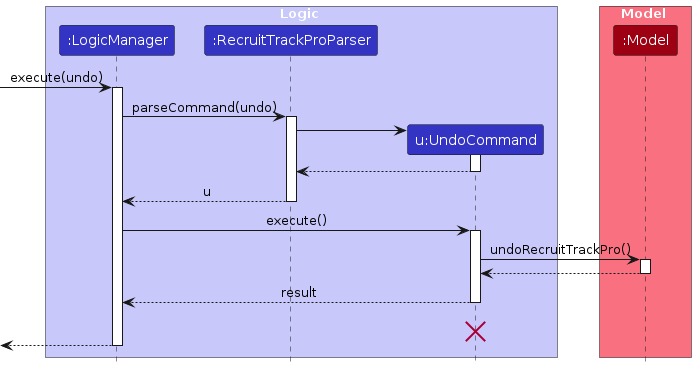
Note: The lifeline for UndoCommand should end at the destroy marker (X) but due to a limitation of PlantUML, the lifeline reaches the end of diagram.
Similarly, how an undo operation goes through the Model component is shown below:
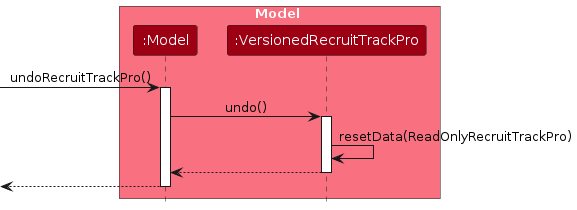
The redo command does the opposite — it calls Model#redoRecruitTrackPro(), which shifts the currentStatePointer once to the right, pointing to the previously undone state, and restores the RecruitTrackPro application to that state.
Note: If the currentStatePointer is at index recruitTrackProStateList.size() - 1, pointing to the latest RecruitTrackPro state, then there are no undone RecruitTrackPro states to restore. The redo command uses Model#canRedoRecruitTrackPro() to check if this is the case. If so, it will return an error to the user rather than attempting to perform the redo.
Step 5. The user then decides to execute the command list. Commands that do not modify the RecruitTrackPro application, such as list, will usually not call Model#commitRecruitTrackPro(), Model#undoRecruitTrackPro() or Model#redoRecruitTrackPro(). Thus, the recruitTrackProStateList remains unchanged.
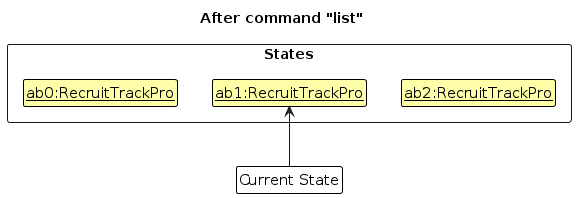
Step 6. The user executes clear, which calls Model#commitRecruitTrackPro(). Since the currentStatePointer is not pointing at the end of the recruitTrackProStateList, all RecruitTrackPro states after the currentStatePointer will be purged. Reason: It no longer makes sense to redo the add n/David … command. This is the behavior that most modern desktop applications follow.
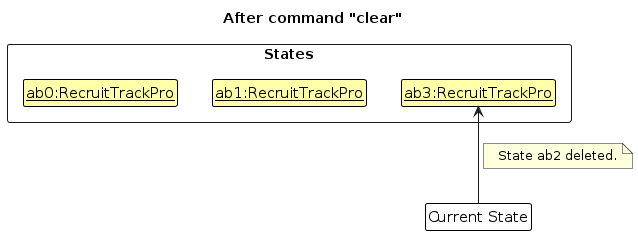
The following activity diagram summarizes what happens when a user executes a new command:
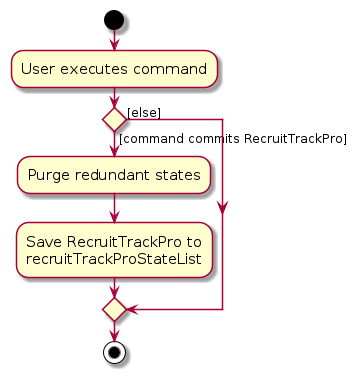
Design considerations:
Aspect: How undo & redo executes:
Alternative 1 (current choice): Saves the entire RecruitTrackPro application.
- Pros: Easy to implement.
- Cons: May have performance issues in terms of memory usage.
Alternative 2: Individual command knows how to undo/redo by itself.
- Pros: Will use less memory (e.g. for
delete, just save the candidate being deleted). - Cons: We must ensure that the implementation of each individual command are correct.
- Pros: Will use less memory (e.g. for
Documentation, logging, testing, configuration, dev-ops
Appendix: Requirements
Product scope
Target user profile:
- HR recruiters who handle a high volume of applicants.
- Prefers desktop applications over web or mobile alternatives.
- Types quickly and favors keyboard shortcuts over mouse navigation.
- Prioritizes speed and efficiency in tracking and managing applicant details.
- Comfortable with command-line interfaces to some extent.
Value proposition: RecruitTrackPro streamlines applicant tracking, ensures quick data retrieval, and reduces administrative workload, making recruitment management more efficient.
User stories
Priorities: High (must have) - * * *, Medium (nice to have) - * *, Low (unlikely to have) - *
| Priority | As a … | I want to … | So that I can… |
|---|---|---|---|
* * * | Recruiter | add a new candidate by specifying their name, phone, and email | store their basic contact information in one place |
* * * | Recruiter | delete a candidate | remove entries for candidates who are no longer relevant |
* * * | Recruiter | list all candidates | have a quick overview of everyone in my current pipeline |
* * * | Recruiter | insert tags such as candidate skills and experience in their profile (e.g., “Java Developer”, “University Graduate”) | easily identify candidates who meet the required skills or experience for a role |
* * * | Recruiter | exit the application via a command | cleanly close the program when I’m finished |
* * * | Recruiter | store all application data locally | access it even if I’m offline or between network connections |
* * | Recruiter | add free-form notes to a candidate’s record | capture extra context or personal observations |
* * | Recruiter | update a candidate’s tags | adjust how candidates are categorized over time |
* * | Recruiter | remove a candidate’s tags | adjust how candidates are categorized over time |
* * | Recruiter | edit a candidate’s details (e.g., phone, email, address) | keep the record accurate when a candidate’s information changes |
* * | Recruiter | find a candidate by name | locate a specific candidate’s details quickly |
* * | Recruiter | sort the candidate list by name | see them in alphabetical order for easier browsing |
* * | Recruiter | find candidates by other fields (e.g., phone, email) | organize the data in the most useful way for my tasks |
* * | Recruiter | find candidates with a set of specific fields (e.g., phone, email) | organize the data in the most useful way for my tasks |
* * | Recruiter | filter for candidates by specific skills (i.e. tags) | find the most qualified applicants for a role |
* | Recruiter | update the (optional) reference contact info for each candidate | have all necessary details for thorough background checks |
* | Recruiter | attach or link a candidate’s resume in their profile | access their CV directly from the application |
* | Recruiter | count the number of times I’ve contacted a candidate | keep track of communication attempts without spamming them |
* | Recruiter | create new tag categories (e.g., “Willing to Relocate”) | capture additional attributes beyond standard fields |
* | Recruiter | mark specific candidates as “High Priority” | focus on them first for interviews or offers |
* | Recruiter | view my command history | reuse previous commands or correct mistakes |
* | Recruiter | undo my last command | revert an accidental action (e.g., deleting the wrong candidate) |
* | Recruiter | redo a command I just undid | restore changes if I reverted them by mistake |
* | New User | access a help command | quickly learn the available features and syntax |
* | Recruiter | create a new job posting (e.g., role title, required skills) | track open positions within my organization |
* | Recruiter | list all active job openings | quickly see every position that needs to be filled |
* | Recruiter | archive a job posting once it’s filled or no longer needed | keep historical records without cluttering the active list |
* | Recruiter | assign a candidate to a job posting | track who is applying or being considered for each position |
* | Recruiter | remove a candidate from a job posting | correct mistakes or reassign them to a more suitable role |
* | Recruiter | view assigned candidates under job postings | see a focused list of all applicants for a specific position |
* | Recruiter | view a list of unassigned candidates | quickly identify who could be matched to newly opened roles |
* | Recruiter | mark a job posting as “Urgent” | prioritize filling it quickly |
* | New User | import candidate data from a CSV | quickly populate the system using existing records |
* | Recruiter | export candidate data to a CSV | create backups or share the list with others |
* | New User | interact with sample data | see how the app will look like in use |
* | New User | purge all current data | delete sample data |
Use cases
(For all use cases below, the System is the RecruitTrackPro and the Actor is the user, unless specified otherwise)
Use Case: UC-001 - Add Candidate
MSS:
User requests to add a candidate with relevant details.
RecruitTrackPro adds the new candidate and displays a success message.
Use case ends.
Extensions:
1a. User did not enter all required fields (name, phone number, email, or address).
1a1. RecruitTrackPro displays an error message.
Use case ends.
1b. User enters an invalid format for any field.
1b1. RecruitTrackPro displays an error message based on the invalid field.
Use case ends.
1c. User enters a duplicate candidate – same name and phone number as an existing candidate.
1c1. RecruitTrackPro displays an error message.
Use case ends.
1d. User enters multiple values for the same field, excluding tag.
1d1. RecruitTrackPro displays an error message based on the duplicated fields.
Use case ends.
1e. User enters the same tag multiple times.
1e1. RecruitTrackPro displays an error message that the tag is duplicated.
Use case ends.
Use case: UC-002 - List Candidate
MSS
User requests a list of all candidates.
RecruitTrackPro displays the list of candidates with relevant details.
Use case ends.
Use Case: UC-003 - Delete Candidate
MSS
User requests to remove a specified candidate from RecruitTrackPro.
RecruitTrackPro updates the displayed list accordingly.
Use case ends.
Extensions
1a. User enters an invalid index (i.e. not a positive integer).
1a1. RecruitTrackPro shows an error message.
Use case ends.
1b. User enters an index that is out of bounds.
1b1. RecruitTrackPro shows an error message.
Use case ends.
Use case: UC-004 - Find Candidates
MSS
User requests to search for candidates by a field and value.
RecruitTrackPro shows the list of matching candidates.
Use case ends.
Extensions
1a. User did not enter a search field or value.
1a1. RecruitTrackPro shows an error message.
Use case ends.
1b. User enters an invalid search field.
1b1. RecruitTrackPro shows an error message.
Use case ends.
1c. User enters an invalid option.
1c1. RecruitTrackPro shows an error message.
Use case ends.
1d. User enters multiple values for the same field.
1d1. RecruitTrackPro displays an error message based on the duplicated fields.
Use case ends.
Use case: UC-005 - Add Tag(s) to a Candidate
Pre-Condition
- The candidate must already exist in the system.
MSS
User selects a candidate and specifies one or more tags.
RecruitTrackPro displays the list of candidates with the updated information.
Use case ends.
Extensions
1a. Candidate does not exist.
1a1. RecruitTrackPro notifies the user that the candidate does not exist.
Use case ends.
1b. User does not specify any tags.
1b1. RecruitTrackPro prompts the user to enter at least one tag.
Use case ends.
1c. User enters a tag that is already associated with the candidate.
1c1. RecruitTrackPro informs the user that the tag already exists for the candidate.
Use case ends.
1d. User enters the same tag multiple times.
1d1. RecruitTrackPro notifies the user that the tag is duplicated.
Use case ends.
Use case: UC-006 - Edit Candidate
MSS
User requests to edit the field(s) of a specified candidate.
RecruitTrackPro shows the list of candidates with the updated information.
Use case ends.
Extensions
1a. Candidate specified by the user does not exist.
1a1. RecruitTrackPro notifies the user that the candidate does not exist.
Use case ends.
1b. User enters an invalid format for any field.
1b1. RecruitTrackPro displays an error message based on the invalid field.
Use case ends.
1c. User enters a name and phone number that is the same as an existing candidate.
1c1. RecruitTrackPro displays an error message.
Use case ends.
1d. User enters the same tag multiple times.
1d1. RecruitTrackPro displays an error message that the tag is duplicated.
Use case ends.
1e. User enters multiple values for the same field, excluding tag.
1e1. RecruitTrackPro displays an error message based on the duplicated fields.
Use case ends.
1f. User enters the same values for the corresponding fields of the specified candidate.
1f1. RecruitTrackPro notifies the user no changes were made.
Use case ends.
Use case: UC-007 - Remove Tag from a Candidate
MSS
User requests to delete a specific tag for a candidate.
RecruitTrackPro removes the specified tag from the candidate’s profile and shows a success message.
Use case ends.
Extensions
1a. User enters an invalid candidate index.
1a1. RecruitTrackPro displays an error message: “The selected candidate does not exist. Please check the index and try again.”
Use case ends.
1b. User does not enter any tags.
1b1. RecruitTrackPro displays an error message: “Tag name cannot be empty. Please enter a valid tag.”
Use case ends.
1c. User specifies a tag which does not exist the candidate's record.
1c1. RecruitTrackPro displays an error message: “Tag does not exist for this candidate. Please enter a valid tag.”
Use case ends.
Non-Functional Requirements
- Should work on any mainstream OS as long as it has Java
17or above installed. - Should work without requiring an installer.
- Should be able to hold up to 1000 persons without a noticeable sluggishness in performance for typical usage.
- Should not be dependent on a remote server.
- Should not use a Database Management System to store data.
- Data should be stored locally in a human editable text file.
- A user with above average typing speed for regular English text (i.e. not code, not system admin commands) should be able to accomplish most of the tasks faster using commands than using the mouse.
- GUI should be usable for screen resolutions 1280x720 and higher.
- User Guide and Developer Guide should be PDF-friendly.
Glossary
- Mainstream OS: Windows, Linux, Unix, MacOS
- Usable: All functions can be used even if the user experience is not optimal
Appendix: Planned Enhancements
Team size: 5
- Add support for other languages: The current system is only able to properly handle inputs in English. It does not handle inputs in other languages well. We plan to improve the system by adding support for non-English languages (e.g. Chinese, Tamil) and right-to-left languages (e.g. Arabic).
- Allow names to have special characters: The current implementation does not allow the
namefield to include special characters. We plan to allow special characters that are commonly used in actual names (e.g.,,-,/). - Make
findhandle partial match: The current implementation for thefindcommand does not handle partial matches
(e.g.find a/01does not match the unit number#01-23of an address). We plan to make thefindcommand handle partial matches for all the parameters. - Update command parameter format: The current implementation identifies command parameters using prefixes
(e.g.n/,a/,c/). If the command parameter has a value that resembles a valid prefix, the parser will not be able to parse it correctly (e.g.n/Bob a/l Johnis treated asname=Bob,address=l John). We plan to change the format of command parameters to be enclosed in{}(e.g.n/NAMEbecomesn{NAME}). - Enforce names to be title case: The current implementation allows users to input the
namefield in any case format
(e.g.aLeX yeOH). However, the checking of duplicate candidates foraddandeditis case-insensitive (i.e.Alex YeohandaLeX yeOHwould be flagged as the same person if they have matching phone numbers). We plan to enforce names to be title case (i.e. all characters are lower case, only the first character of each word is upper case) to reduce confusion in the user interface, and user experience.
Appendix: Instructions for manual testing
Given below are instructions to test the app manually.
Note: These instructions only provide a starting point for testers to work on; testers are expected to do more exploratory testing.
Launch and shutdown
Initial launch
Download the jar file and copy into an empty folder.
Open a terminal in the folder containing the JAR file and run:
java -jar recruittrackpro.jarExpected: Shows the GUI with a set of sample candidates. The window size may not be optimum.
Saving window preferences
Resize the window to an optimum size. Move the window to a different location. Close the window.
Re-launch the application using the same command:
java -jar recruittrackpro.jarExpected: The most recent window size and location is retained.
Deleting a candidate
Deleting a candidate while all candidates are being shown
Prerequisites: List all candidates using the
listcommand. Multiple candidates in the list.Test case:
delete 1
Expected: First candidate is deleted from the list. Details of the deleted candidate shown in the result message.Test case:
delete 0
Expected: No candidate is deleted. Error details shown in the result message.Other incorrect delete commands to try:
delete,delete x,...(where x is larger than the list size)
Expected: Similar to previous.
Deleting a candidate while some candidates are being shown
Prerequisites: Filter the list of candidates using the
findcommand. Multiple candidates in the list.Test case:
delete 1
Expected: First candidate is deleted from the list. Details of the deleted candidate shown in the result message.Test case:
delete 0
Expected: No candidate is deleted. Error details shown in the result message.Other incorrect delete commands to try:
delete,delete x,...(where x is larger than the list size)
Expected: Similar to previous.
Finding a candidate
Finding a candidate by name
Prerequisites: List contains the set of sample candidates.
Test case:
find n/alex david
Expected: List updates and only shows Alex Yeoh and David Li.Test case:
find -ca n/alex david
Expected: List updates and is empty.Test case:
find n/
Expected: List does not update. Error details shown in the result message.
Finding a candidate by multiple fields
Prerequisites: List contains the set of sample candidates.
Test case:
find n/bernice t/python
Expected: List updates and only shows Bernice Yu and Roy Balakrishnan.Test case:
find -ca n/bernice t/python
Expected: List updates and only shows Bernice Yu.Test case:
find n/ t/python
Expected: List does not update. Error details shown in the result message.